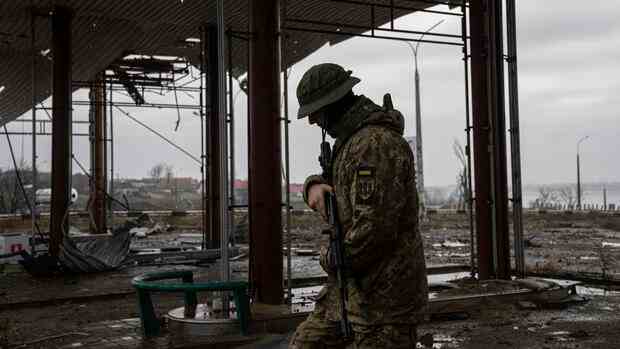Kherson There is the hand grenade that was stuck in the detergent compartment of a washing machine in a house in Kherson. Or the street sign positioned to direct passers-by into a deadly minefield. There’s the police station that allegedly served as a torture chamber for the Russian occupiers, but is so riddled with booby traps that Ukrainian demining teams can’t even begin to look there for evidence.
It was exactly one month ago on Sunday that Russian troops withdrew from the Ukrainian city of Cherson and its environs after eight months of occupation. In Ukraine, it sparked jubilation across the country. But life in the city to the south is still far from normal. Because the withdrawing Russians left behind ugly surprises of all kinds.
In addition, the city continues to be under artillery fire from new positions along the Dnipro. According to the regional administration, dozens of people were killed or injured in Kherson last month, including a child.
Sometimes the power supply works and sometimes it doesn’t. The water is mostly flowing again, and interiors can now also be heated again – but only in 70 to 80 percent of Cherson, after the Russians blew up a large heating plant that supplied a large part of the city in November. The authorities and the citizens see themselves faced with problems and dangers every day.
Top jobs of the day
Find the best jobs now and
be notified by email.
On Friday alone, the region was hit 68 times by mortar, artillery, tanks and rockets, according to the local affiliate of radio station Suspilne. In November, around 5,500 people left Cherson on board evacuation trains. Clearance teams made 190 kilometers of roads accessible again.
Most of the population has fled
When relief supplies arrived in trucks a month ago, war-weary and desperate residents gathered in central Freedom Square to receive them. After a Russian attack on the square, when many people were queuing in front of a bench, such crowds have become less frequent. Aid is now prioritized at smaller, more discreet distribution points.
The people in the city lack the necessary goods.
(Photo: AP)
According to local sources, about 80 percent of the city’s approximately 320,000 pre-war residents fled when Russian forces entered, just days after the Feb. 24 invasion. With only 60,000 to 70,000 remaining, Kherson now looks like a ghost town. Those who are still there try to leave their houses and apartments as little as possible.
“Life is returning to normal, but there is a lot of shelling,” said Valentyna Kytayska, who lives in the nearby village of Chornobayvka. The 56-year-old lamented the nightly cannon thunder and the uncertainty of where the Russian projectiles would land.
Normality is a relative term for a country at war. There is no telling whether what Russia calls a “military special operation” will end in days, weeks, months, or even years. In the meantime, however, efforts to restore order and clear abandoned mines continue – in harsh wintry conditions.
Several minesweepers died in action
“The difficulty is quite simple, it’s the weather conditions,” said a member of a Ukrainian Ordnance Disposal Unit, war-named Technik. Some of the equipment doesn’t work in the freeze “because the ground is frozen like concrete.” Extra teams could help shoulder the heavy workload, he said. In the month since the Russian military left, “we have found and removed several tons of mines,” Technik said. His unit was only concentrated on about ten square kilometers.
According to Ukrainian information, several tons of mines were found and removed.
(Photo: IMAGO/Ukrinform)
In one neighborhood, a main street was blocked with a sign warning of mines there and telling passers-by to take a smaller street as a detour. In fact, it was this road that was mined and claimed the lives of some deminers. A few weeks later, four police officers died there, including the police chief of the northern city of Chernihiv, who had come to Kherson to provide support.
More Handelsblatt articles on the war in Ukraine:
The generally poor condition of the weather-damaged roads helped the retreating Russians to hide their deadly booby traps, for example in potholes. Sometimes they also cut up the asphalt to place mines there.
Ukraine’s explosive ordnance clearance teams are working their way from house to house. In this way they want to ensure that the owners or previous residents can return reasonably safely. Experts say this can take up to three days for a single home.
A team found a hand grenade in a house placed in a washing machine in such a way that opening the detergent drawer would have set off an explosion. The city’s main police station, where detainees were reportedly tortured by the Russians, is peppered with explosives. As demining teams attempted to make their way inside, part of the building blew up. Efforts were then put on hold for the time being.
Long-term questions also arise: Cherson is located in an important agricultural region. The fields are so heavily mined that 30 percent of the arable land should probably not be planted in the spring, as Technik, the mine clearer, believes.
More: Continuous Russian bombing – When will Putin run out of missiles?
